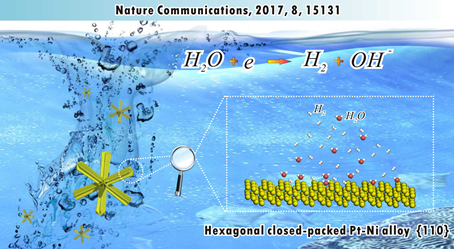
Noble metal based nanomaterials are promising functional materials, which have potential applications in many important fields. The discovery of their new crystal phase provides an opportunity for achieving novel functionalities due to different atomic arrangements and electronic structures of allomorphs, and thus possesses great significance. Pt-Ni alloy is one of the best catalysts for many energy conversion applications, such as oxygen reduction (ORR) and hydrogen evolution (HER). In the past few decades, great efforts have been devoted to improving the catalytic efficiency through tailoring the size, morphology and composition of Pt-Ni alloy NCs, but all the reported Pt-Ni alloys adopt the typical face-centered cubic (fcc) crystal phase. The regulation of the crystal phase of Pt-Ni alloys was unrevealed.
Recently, Xie group reported a successful synthesis of metastable hexagonal closed-packed (hcp) Pt-Ni alloy nano-multipods in a mild solvothermal condition for the first time. Detailed analysis showed that the building blocks of Pt-Ni alloy nano-multipods were highly-concave hexagonal prisms assembled by six nanosheets of about 2.5 nm in thickness and exposed with (11-20) facets. Owing to the unique crystal structure and large surface area due to the excavated polyhedral morphology, the hcp Pt-Ni alloy excavated nano-multipods exhibited a superior catalytic ability towards the HER. The specific area current density of hcp Pt-Ni excavated multipods at -70 mV is respectively 4.1 and 1.8 times higher than that of commercial Pt/C and their fcc counterpart. The mass current density of the as-prepared hcp Pt-Ni excavated nano-multipods reaches 3.28 mA µgPt-1, which outperforms the currently reported catalysts. This work was supervised by Pro. Zhaoxiong Xie and associate Pro. Yaqi Jiang, the experimental sections were conducted by Zhenming Cao, Qiaoli Chen, Jiawei Zhang, Huiqi Li, Shouyu Shen, and Bang-an Lu, the theoretical calculations was carried out by Pro. Gang Fu.
This work was supported by the National Basic Research Program of China (Grants 2015CB932301), the National Natural Science Foundation of China (Grants 21333008, 21603178 and J1030415), and the Natural Science Foundation of Fujian Province of China (No. 2014J01058).